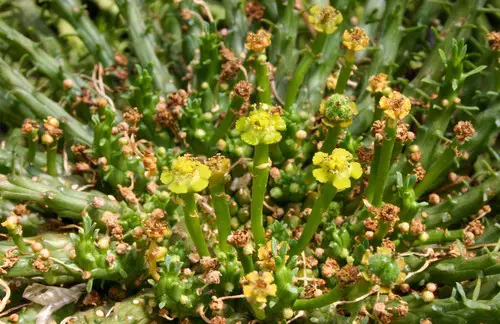African Milk Tree, also known as Euphorbia Trigona, is a popular succulent plant that is native to West Africa. It is a low-maintenance plant that is easy to care for and can thrive in a variety of environments. However, if you notice that the leaves or stem of your African Milk Tree turning brown, it could be a sign that something is wrong.
There are several reasons why an African Milk Tree may turn brown. One common cause is overwatering, which can lead to root rot and other fungal infections. Another possible cause is underwatering, which can cause the leaves to dry out and turn brown.
Other factors that can contribute to browning leaves include pests, disease, and environmental stress. Understanding the cause of the problem is the first step in finding a solution to revive your plant.
Key Takeaways
- African Milk Tree is a low-maintenance succulent that is easy to care for.
- Brown leaves on an African Milk Tree can be a sign of overwatering, underwatering, pests, disease or environmental stress.
- Identifying the cause of the problem is the first step in finding a solution to revive your plant.
Check out these other related posts:
- Pitcher Plant Pitchers Turning Brown
- Why Does My Pothos Have Brown Spots?
- Brown Spots On Mint Leaves
Understanding African Milk Tree
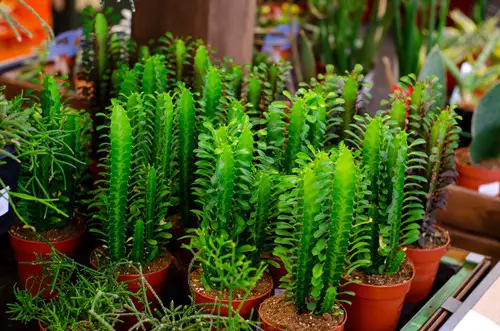
African Milk Tree, also known as Euphorbia trigona, is a succulent plant that belongs to the Euphorbia family. It is native to Central Africa, particularly Angola and Zambia. The plant is named after its milky sap, which is toxic and can cause skin irritation and eye damage.
The African Milk Tree is a cactus-like plant that can grow up to 6 feet tall. It has a candelabra-like shape with three or four sides, and each side has rows of small, oval leaves that are green in color. The plant’s stem is covered with sharp thorns, which can cause injury if not handled with care.
One of the unique features of the African Milk Tree is its ability to change color. The plant can turn from green to red, depending on the amount of sunlight it receives. The Royal Red and Rubra varieties of the plant have vibrant red stems and leaves, making them popular houseplants.
African Milk Tree is a hardy plant that requires minimal care. It is a drought-tolerant plant that can survive in hot and dry conditions. It is also a low-maintenance houseplant that can thrive in a variety of indoor environments.
However, African Milk Tree can turn brown due to several reasons, including overwatering, poor drainage, and fungal infections. It is essential to ensure that the plant is watered sparingly and that the soil is well-draining. The use of a soil mix that includes perlite can help improve drainage.
In conclusion, the African Milk Tree is a fascinating plant that can add a unique touch to any indoor or outdoor space. Understanding the plant’s characteristics and requirements can help prevent problems such as browning leaves. With proper care and attention, African Milk Tree can thrive and bring joy to its owner for many years.
Common Problems and Solutions
1. Browning and Yellowing
One of the most common issues with African Milk Trees is browning and yellowing of leaves. This could be caused by a variety of factors, including overwatering, underwatering, pests, diseases, sunburn, and heat damage. It is important to identify the cause of the problem to find the right solution.
2. Overwatering and Underwatering

Overwatering and underwatering can both cause problems for African Milk Trees. Overwatering can lead to root and stem rot, while underwatering can cause the plant to wilt and the leaves to turn brown and dry. It is important to find the right balance of watering to keep the plant healthy.
3. Pests and Diseases
Spider mites, scale, and mealy bugs are common pests that can attack African Milk Trees. These pests can cause damage to the leaves, stems, and flowers of the plant. Diseases such as root and stem rot can also be a problem, especially if the plant is overwatered.
4. Sunburn and Heat Damage
African Milk Trees are native to hot, arid regions and can tolerate high temperatures. However, direct sunlight can cause sunburn and heat damage to the leaves and stems. It is important to provide some shade during the hottest parts of the day to prevent damage.
5. Root and Stem Rot
Root and stem rot can be caused by overwatering or poor drainage. This can cause the plant to wilt and the leaves to turn brown and mushy. It is important to ensure that the soil is well-draining and that the plant is not overwatered.
Proper Care and Maintenance
Proper care and maintenance are essential to keep African Milk Trees healthy and prevent them from turning brown. This section will cover the necessary steps to take care of these plants.
1. Watering and Moisture Management
African Milk Trees are drought-tolerant plants that prefer to be underwatered than overwatered. Overwatering can lead to root rot and cause the leaves to turn brown. Therefore, it’s important to allow the soil to dry out completely before watering again. The frequency of watering will depend on the size of the pot, the soil mix, and the amount of sunlight the plant receives.
To avoid waterlogging, ensure that the pot has drainage holes and use a well-draining soil mix. A good soil mix for African Milk Trees is one that contains equal parts of potting soil, perlite, and sand. Adding peat moss to the mix can help retain moisture.
2. Light and Temperature Requirements
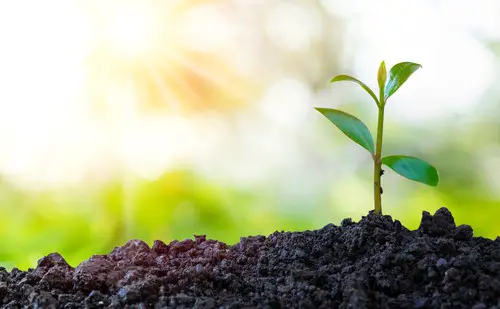
African Milk Trees thrive in bright, indirect light. Direct sunlight can scorch the leaves and cause them to turn brown. If the plant is not getting enough light, it may become leggy and lose its shape. If the plant is receiving too much light, it may become stunted and turn yellow.
These plants are hardy and can tolerate a wide range of temperatures, but they prefer temperatures between 65°F and 85°F. In colder regions, it’s best to keep them indoors or in a greenhouse.
3. Soil and Drainage
African Milk Trees prefer well-draining soil that is slightly acidic with a pH of 6.1 to 7.8. Heavy clay soil can hamper the plant’s growth, so it’s essential to amend it with sand or perlite to improve drainage. Sandy and sandy loam soils are ideal for these plants.
4. Pruning and Propagation
Pruning is essential to keep African Milk Trees looking neat and tidy. It also encourages new growth and prevents the plant from becoming too leggy. Prune the plant in the spring or summer when it’s actively growing.
Propagation is easy with African Milk Trees. They can be propagated from stem cuttings taken in the spring or summer. Allow the cuttings to dry out for a few days before planting them in a well-draining soil mix. Keep the soil moist and warm until new growth appears.
Safety Measures and Precautions
African Milk Tree (Euphorbia trigona) is a beautiful succulent plant that can add a touch of greenery to any indoor space. However, it is important to be aware of the potential hazards associated with this plant. Here are some safety measures and precautions to keep in mind when handling African Milk Tree:
1. Toxicity
The milky white sap that oozes from the African Milk Tree when it is cut or damaged is toxic to both humans and pets. The sap contains a chemical called diterpene esters, which can cause skin irritation, eye irritation, and even vomiting and diarrhea if ingested.
Therefore, it is important to avoid contact with the sap and to keep the plant out of reach of children and pets.
2. Thorns
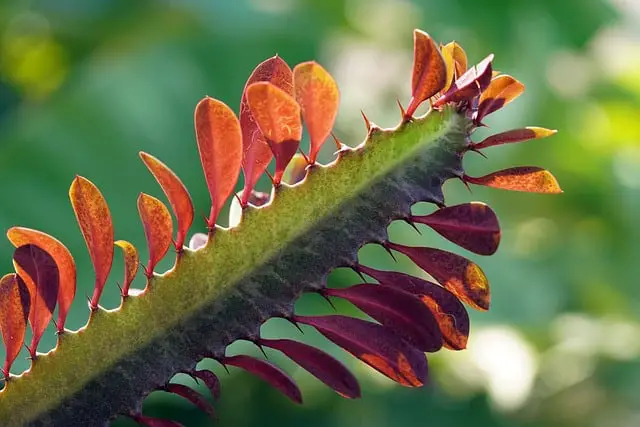
The African Milk Tree has sharp thorns that can cause injury if not handled carefully. It is recommended to wear gloves when handling the plant to avoid getting pricked by the thorns.
3. Gloves
It’s highly recommended to wear gloves when handling African Milk Tree. Gloves can protect your hands from the thorns and the toxic sap.
4. White Sap
If you come into contact with the white sap of an African Milk Tree, it is important to wash the affected area with soap and water immediately. If the sap gets into your eyes, rinse them with water for at least 15 minutes and seek medical attention if necessary.
5. Pets
African Milk Tree is toxic to pets, especially cats and dogs. If ingested, it can cause vomiting, diarrhea, and even death in severe cases. Therefore, it is important to keep the plant out of reach of pets and to seek veterinary attention immediately if you suspect your pet has ingested any part of the plant.
In conclusion, while the African Milk Tree is a beautiful and low-maintenance plant, it is important to be aware of the potential hazards associated with it. By taking the necessary safety measures and precautions, you can enjoy the beauty of this plant without putting yourself or your pets at risk.
Special Features and Symbolism
The African Milk Tree, also known as Euphorbia trigona, is a unique and fascinating succulent that is native to Central and West Africa. It is a highly architectural and curious houseplant, known for its tall, columnar shape and its striking ridges and spikes that run along its stem.
These ridges and spikes give the plant a distinct and striking appearance, making it a popular choice for those looking for a unique and eye-catching addition to their indoor garden.
In addition to its striking appearance, the African Milk Tree is also known for its symbolism. In many cultures, the plant is considered to be a symbol of good luck and prosperity. It is believed that keeping the plant in the home or office can bring good fortune and positive energy into the space.
Some also believe that the plant has the power to ward off negative energy and evil spirits.
Despite its many positive attributes, it is important to note that the African Milk Tree is also toxic to humans and pets. The plant contains a white, latex-like fluid that can cause skin irritation and other health problems if ingested. As such, it is important to handle the plant with care and to keep it out of reach of children and pets.
Final Thoughts on African Milk Tree Turning Brown
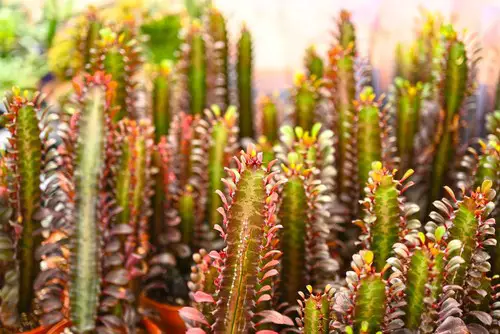
In conclusion, the African Milk Tree is a drought-tolerant and low-maintenance plant that is easy to care for, making it a popular choice for those looking for a unique addition to their indoor garden. However, the plant can develop brown spots on its leaves due to overwatering, fungal infections, or too much direct sunlight.
To prevent brown spots from appearing on the leaves, it is crucial to ensure that the plant is not overwatered and receives the correct amount of sunlight. If the plant is exposed to too much direct sunlight, it can cause brown patches to appear on the leaves. Therefore, it is recommended to place the plant in an area that receives indirect sunlight.
Moreover, the African Milk Tree requires minimal care, making it an ideal plant for those who do not have much time to care for their plants. However, it is important to note that the plant can grow up to 8 feet tall if it is repotted regularly, so it is essential to provide it with enough space to grow.
To care for the African Milk Tree, it is recommended to use well-draining soil and water the plant sparingly. The plant does not need much water, and overwatering can lead to root rot, which can cause brown spots to appear on the leaves. Additionally, it is recommended to fertilize the plant once a month during the growing season.
Overall, by following the care tips mentioned above, the African Milk Tree can thrive and add a touch of unique beauty to any indoor garden.
Frequently Asked Questions
Why is my Euphorbia Ammak turning brown?
There are several reasons why your African milk tree might be turning brown. One possible cause is overwatering, which can lead to root rot and cause the leaves to turn brown and fall off.
Another reason could be poor soil drainage, which can cause the roots to become waterlogged and lead to the same symptoms. Finally, exposure to cold temperatures or drafts can also cause the leaves to turn brown.
How often should I water my African milk tree?
African milk trees are succulents and do not require frequent watering. In fact, overwatering is a common cause of problems for these plants. It is best to wait until the soil is completely dry before watering again. Depending on the temperature and humidity of your environment, this could mean watering every few weeks to once a month.
Do African milk trees like full sun?
African milk trees prefer bright, indirect light and can tolerate some direct sunlight. However, too much direct sunlight can cause the leaves to burn. It is best to place your plant near a window that receives bright, filtered light for most of the day.
How do you save an African milk tree?
If your African milk tree is turning brown and losing leaves, it may be possible to save it with proper care. First, make sure the plant is not overwatered and that the soil has good drainage.
If the soil is too wet, remove the plant from the pot and let the roots dry out for a few days before repotting in fresh, well-draining soil. Additionally, make sure the plant is not exposed to cold temperatures or drafts. With proper care, your African milk tree should recover within a few weeks.
What causes African milk tree leaves to fall off?
There are several reasons why African milk tree leaves may fall off. Overwatering and poor soil drainage can cause root rot, which can lead to leaf loss. Exposure to cold temperatures or drafts can also cause leaves to fall off. Finally, pests such as spider mites or mealybugs can cause significant damage to the plant, including leaf loss.
How can I prevent my African milk tree from corking?
Corking is a natural process that occurs as the plant ages. There is no way to prevent it, but you can slow down the process by providing proper care. Make sure your plant is not overwatered and that the soil has good drainage. Additionally, make sure the plant is not exposed to cold temperatures or drafts. With proper care, your African milk tree should remain healthy and vibrant for many years.

Hey, I’m Lisa and I’ve been an avid gardener for over 30 years. I love writing, talking and living in the garden! Feel free to connect with me on my socials below

